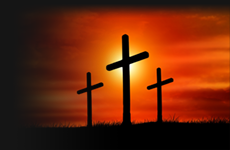
Bible Art

The Baptism of Christ
Artist: Andrea del Verrochio
1472
Painting
The Baptism of Christ is a famous painting made by Leonardo da Vinci's master, Andrea del Verrochio at circa 1472 in his studio in Italy. The painting was completed by Verrochio in collaboration with his apprentice, Leonardo da Vinci who painted and finished the details of some parts of the painting, particularly the angel. The painting was an altarpiece commissioned by the monks of the San Salvi Church near Florence.

The Baptism of Christ
Artist: Giovanni Baronzio
1335
Tempera (on wood)
A nude man, Jesus, stands with hands together in prayer, hip-deep in a stylized river with a bearded man wearing a fur-like garment on a rocky bank to one side and two winged angels on the other, all against a gleaming gold background in this vertical painting. Another bearded man wearing a white robe floats in a blue field at the top center of the panel. All the people have pale skin, brown hair, and gold halos encircle their heads. At the center of the painting, Jesus’s body is angled to our left, and he tips his head the same direction. Jesus has shoulder-length hair and a trimmed beard. Slate-blue water reaching his hips is painted with regular, white, curving lines to suggest flowing water. Standing on the flat top of a tan-colored rock to our left, the other man head has raggedy, darker brown hair and a fuller beard. His brow is furrowed, and he has dark eyes. He wears the brown, fur-like garment under a white robe.
1 2 3 4 5 6 7 8 9 10 11 12 13 14 15 16 17 18 19 20 21 22 23 24 25 26 27 28 29 30 31 32 33 34 35 36 37 38 39 40 41 42 43 44 45 46 47 48 49 50 51 52 53 54 55 56 57 58 59 60 61 62 63 64 65 66 67 68 69 70 71 72 73 74 75 76 77 78 79 80 81 82 83 84 85 86 87 88 89 90 91 92 93 94 95 96 97 98 99 100 101 102 103 104 105 106 107 108 109 110 111 112 113 114 115 116 117 118 119 120 121 122 123 124 125 126 127 128 129 130 131 132 133 134 135 136 137 138 139 140 141 142 143 144 145 146 147 148 149 150 151 152 153 154 155 156 157 158 159 160 161 162 163 164 165 166 167 168 169 170 171 172 173 174 175 176 177 178 179 180 181 182 183 184 185 186 187 188 189 190 191 192 193 194 195 196 197 198 199 200 201 202 203 204 205 206 207 208 209 210 211 212 213 214 215 216 217 218 219 220 221 222 223 224 225 226 227 228 229 230 231 232 233 234 235 236 237 238 239 240 241 242 243 244 245 246 247 248 249 250 251 252 253 254 255 256 257 258 259 260 261 262 263 264 265 266 267 268 269 270 271 272 273 274 275 276 277 278 279 280 281 282 283 284 285 286 287
